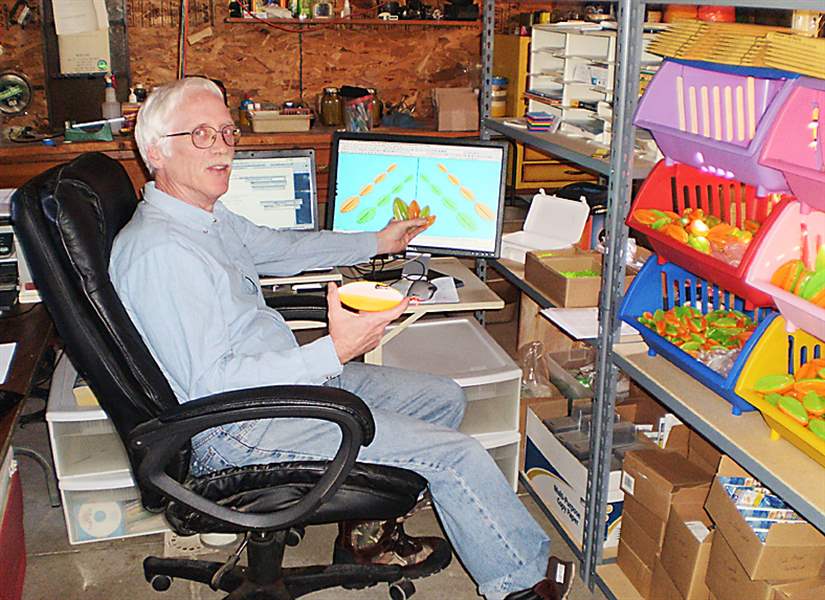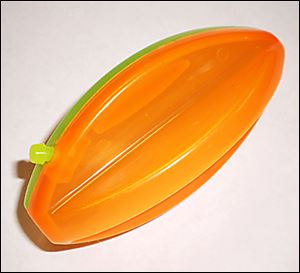
Angler convinced he has crafted the better bobber
4/14/2013
The Barberton, Ohio, basement workshop of Paul Lieb is where the BulletBobber prototype was crafted.

The Barberton, Ohio, basement workshop of Paul Lieb is where the BulletBobber prototype was crafted.
There is no Biblical record to confirm this, but we can comfortably assume that when Adam and Eve went fishing in the Garden of Eden, they probably used bobbers.
It was undoubtedly a simple float that bounced along on the water, and then plunged under the surface to indicate a strike. A lot has changed since the genesis of the fishing bobber, but not much about the bobber itself is any different.
Colors, shapes, and sizes vary, but the essential element is the same — attach a line to a floating material, and then watch and wait.
Most fishermen believed the better mousetrap would get here before the bobber went high-tech, or even medium-tech. But after an accidental convergence of concept-rich tangents, random materials, and a creative mind, in a basement in eastern Ohio, the bobber has skipped a few hundred generations and leaped into the 21st century.
Paul Lieb was working in Barberton for the Babcock & Wilcox Co., a huge multinational corporation that has a team of engineers, chemists, program managers, physicists, and technicians involved in manufacturing things such as naval nuclear reactors and environmental control technologies for power plants.
“My job made me be creative,” Lieb said.
When the operation at work went fully-computerized, Lieb was told to get rid of his drafting tools. He took them home and parked them on his work bench. While cleaning up his basement workshop, Lieb picked up an old egg-shaped, lead-centered foam bobber, and the avid fisherman thought about how he could modify it to do more.
His ellipse template was nearby, and some scrap balsa was sitting there, just collecting dust. Because the wheels never stop turning in the brain of a tinkerer, Lieb considered the possibilities. He cut an ellipse from the balsa, notched it in half, fit the two pieces together, and continued to let the ideas play out through his hands.
“I remembered back when my dad had taught me how to build a kite, and how to put one-third above the connection and two-thirds below, so I followed that approach,” Lieb said. He drilled an angled hole, starting a third of the way back from the front of his prototype, and used a piece of small plastic tube to thread a fishing line through it, and used a toothpick to hold the line in place.

A small nub on the edge of the BulletBobber locks the fishing line in place.
What Lieb had was potentially a three-dimensional ellipses, or a float with two keels and pair of wings for stability — a steerable bobber. He took his son fishing the next day, testing this nameless gizmo near the spillway at Nimisila Reservoir, southeast of Barberton.
“I tossed it out and then gave it a tug, and it just flipped over and started going the other way,” Lieb said. “I got a rush. I’d been fishing all my life and couldn’t believe I just came up with an improvement on the bobber. I flipped it over and it worked 10 times in a row. I had no idea that was going to happen.”
Lieb continued to tweak and modify and fine-tune. “I found out that the angles were very critical,” he said. “That’s probably why nobody ever discovered this before.”
That was back in 2002. The following summer Lieb went to Las Vegas to a huge fishing tackle show, hoping to take the industry by storm. He showed a video demonstrating the maneuverability of his BulletBobber, which was so named because it would go where you aim it. Lieb spread the gospel, he gave out samples, and then he waited.
No bites.
“I found out the hard way that the major tackle manufacturers don’t want outside ideas,” Lieb said. A decade later, Lieb is still searching for a licensing deal, but still making the BulletBobber.
Using the Internet and word of mouth, Lieb has sold his bobbers in all 50 states, every Canadian province, Indonesia, Czechoslovakia, and most of the other European countries. He recently sent an order of bobbers to Greece — his 17th foreign country.
“One guy from South Africa ordered a whole case of them to sell,” Lieb said.
His work is protected, since in his time at Babcock & Wilcox, Lieb had experience securing solid patents. But he remains bewildered. There are roughly 100 million fishing floats sold in the U.S. every year, and just a tiny thread of a fraction of a percentage of those are Lieb’s BulletBobbers.
“This went from a serious business venture to now just a supplement to my retirement,” he said, “but the most frustrating thing is — I can’t get enough fishermen to know about it.”
The bobbers come in four sizes, and are also available in combination packs at the BulletBobber.com Website. For $8 you can get four of the small BulletBobbers, or three of the medium-sized, or two of the large.
The line is threaded through holes on either side of the bobber, and a small plastic stop locks the line in place. Cast and retrieve, and a little flick of the wrist flips the direction the bobber will track.
“When you are fishing, the key is how much time a lure or bait spends where the fish are, and this bobber lets you keep the bait where the fish are,” Lieb said. “If you rig it right, the learning curve is not very long. You pick up the tricks pretty quickly.”
He believes an ideal application for the BulletBobber would be during the spring walleye run on the Maumee and Sandusky rivers, since anglers could set the float at the right height to keep from snagging the rocky river bottom, and then steer it back and forth across the spawning areas.
Lieb continues to explore the application of creative drafting and engineering in the sport of fishing. He has created DualFin mini planer boards and also sells those on his website.
The inventor remains philosophical about the place he feels his BulletBobber should hold in most tackle boxes, and he hopes it eventually becomes an essential item for anglers. Lieb is not bitter, but often wonders why no other basement workshop hatched this relatively simple merger of physics and buoyancy.
“With how long man has been fishing on this planet, somebody else should have thought this up so I could have been fishing with it all my life.”
Contact Blade outdoors editor Matt Markey at: mmarkey@theblade.com or 419-724-6068.